Hardwood Floors After a Clean, Screen and Recoat
Recently we were called in to have a look at a very scratched up floor in a house in Lemont. The floors themselves weren’t that old… but they sure had seen better days. The finish was scratched up to bits and looking pretty worse for wear.
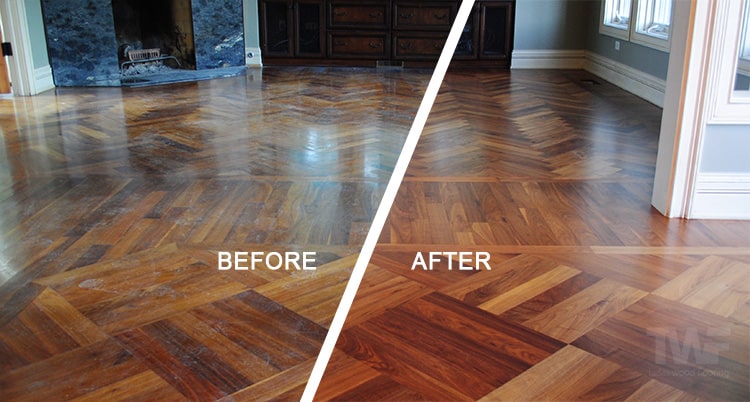
We were asked if there was anything that could be done… without having to start from scratch and re-sand the entire floor all over again. Thankfully in this case we could.
One of the services we offer is called a ‘Clean, Screen and Recoat’ (sometimes known as a ‘buff and coat’). It’s a process where we rejuvenate the floor by applying a fresh coat of finish over top of the existing one. This floor was the perfect candidate for this procedure.
Before I get into the details of what is involved in a clean, screen and recoat, and whether a floor can be recoated or not, have a look at the condition of this floor in the pictures below…
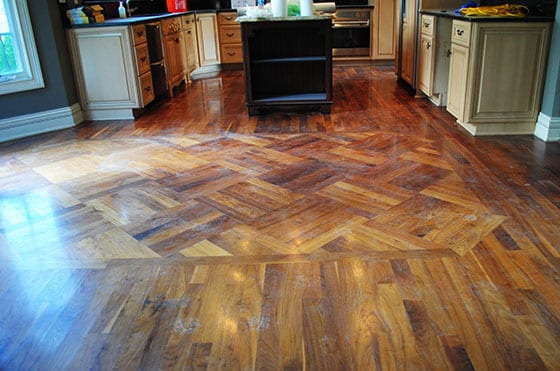
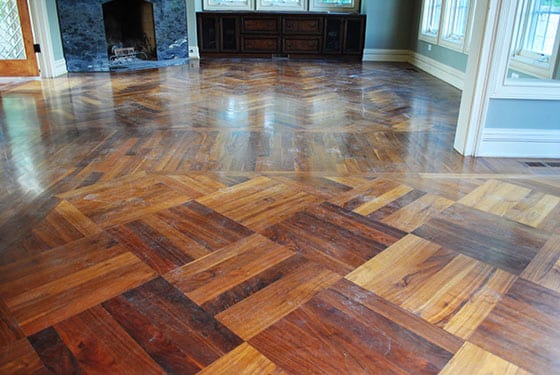
This is what large dogs, wearing shoes inside and not using protective felts under your furniture will do to a floor.


That’s a LOT of scratches!

As you can see, these hardwood floors had seen much better days.
Further below you can see the results after we finished – but first I’ll explain the process we go through to rejuvenate hardwood floors like this…
7 step Clean, Screen and Recoat process:
- To start off, the floors are thoroughly vacuumed and any minor repairs needing fixed are completed.
- The second step is an intense clean with a special product that removes the build-up of dirt and cleaning products (with some exceptions). The remover product is applied to the floor and then a buffer is used with a scrubbing pad to mechanically deep clean the floor. This is the longest stage of the process as its labor intensive and very important to do right and not miss any areas.
- Once that is done the next step is to rinse the dirt off with a cleaning product using a specially built hardwood floor scrubbing machine. It sprays the cleaner out the front, scrubs the floor and then vacuums up the dirty solution behind it. Depending on how dirty the floors are this step may have to be repeated.
- Then the floor is given time to allow it to completely dry.
- Once dry, the buffer comes out again and the floor is buffed with an appropriate sanding screen which removes most scratches and helps aid with the mechanical adhesion of the top coat.
- After that the floor is thoroughly vacuumed and tacked to remove any last trace of dust.
- The last step is applying the finish – one or two coats depending on the project.
As you can see there is quite a bit to the Clean, Screen and Recoat process… but it is WAY less work compared to a full sand and refinish. It also is FAR quicker and cleaner than going back to bare wood.
It can usually be done in a day, depending on the size and scope of the project. You can walk on your floors in socks the following day.
Would you like to see the results?







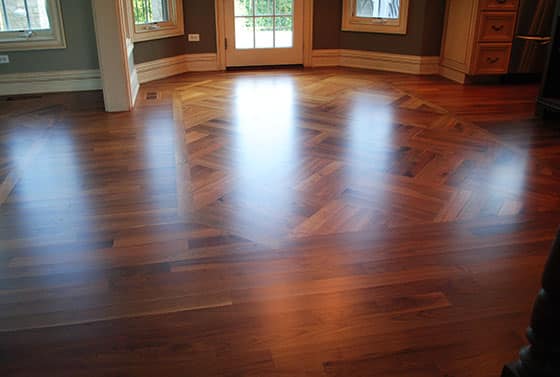
What a difference!
And all in one day.
So what floors qualify for a Clean, Screen and Recoat?
If you floor has scratches that are not too deep, you haven’t used a floor cleaner that can’t be recoated over (see this post here: Don’t use these cleaners), there are no large areas of damage that have worn through the finish, and you don’t want to change the color of the wood floors… then your floors could be a potential candidate.
Please understand that screening and recoating hardwood floors will not give the same results as sanding the floors back to bare wood.
If there is water damage or other marks in the hardwood floors – they will not be removed. If you have overwood, minor cupping or any other unevenness in your floor – this won’t be removed either as there is no sanding being done.
But… if your hardwood floors are in relatively good shape, are flat and only have surface damage… then it really is worth looking into. In fact we recommend our clients to do it every so often as a way to maintain the top coat and keep your floor protected and looking great.
A Word of Caution
Please be careful when considering a screen and recoat (buff and coat).
There is a very high rate of failure in the industry when it comes to recoats.
As it is an easier process compared to full sanding, and it is a lot cheaper to set up a business doing this, many people get into it without proper professional hardwood floor refinishing training and experience. Usually by way of a franchise.
One of the big reasons for the high failure rate is the lack of, or not thorough enough, cleaning. It’s the most crucial part of a screen and recoat.
If only a screen is used across a wood floor, it doesn’t clean it or remove any contamination. All buffing will do is smear the contaminated residue further across the floor. If you only use a solution of water and vinegar prior to screening and buffing, it won’t properly remove any cleaning, oil soap or polish residue.
The proper way is to use professional cleaning and stripping products, along with a power scrubber to remove all traces of contaminants.
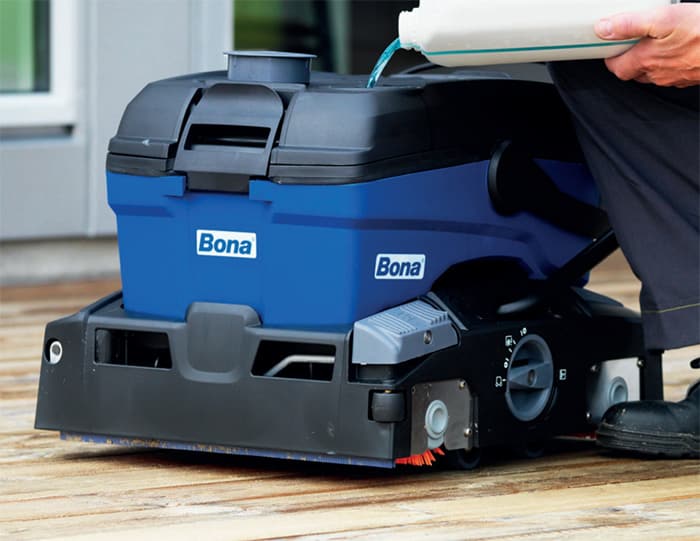
Have a look at a previous post we wrote to show what can go wrong if you hire someone that doesn’t know what they are doing: Buff and Coat Hardwood Floors.
A good rule of thumb would be that if the person you are considering to hire doesn’t fully sand, stain and finish hardwood floors from scratch on a professional level, then be very wary of their qualifications to do this very risky procedure.
One last piece of advice for those considering this – you need to do thorough adhesion testing in different areas to make sure this procedure will work on your floors. Not testing can lead to disastrous consequences and a bigger mess that what you started out with, like this unfortunate mess…
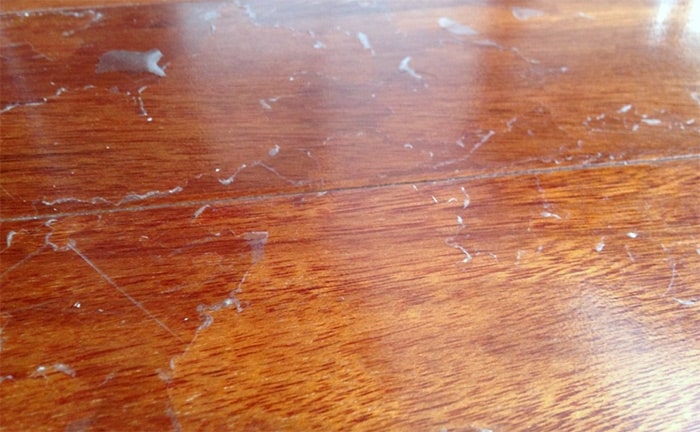
Not something you want to have happen to you.
If you are considering freshening up your hardwood floors and you feel that they might be a good candidate for a Clean, Screen and Recoat, give us a call and we will be happy to come out and have a look at your wood floors for you. We will do a full adhesion test and discuss the results with you as well as the best way forward.
Hopefully your hardwood floors will be a candidate and turn out as good as the floor above.
–
Updated Jan 2023

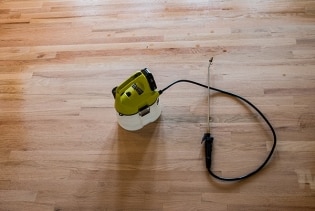
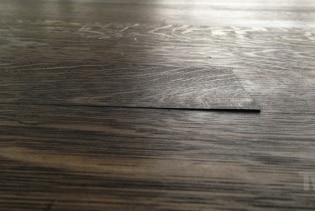
Tadas,
I wish you wanted to take a road trip to SC because I would hire you in instant. Love the information you have provided, as it has helped me immensely.
Most of your displayed work and comparisons are on oak or very hard wood. I built a log home myself 15 years ago, and I installed heart pine floors throughout the entire home, including kitchens and bathrooms. When I installed these I put min wax stain and several coats of polyurethane. Considering 3 boys, dogs, and the fact it is a working farm, the floor has seen its share of wear. I’m getting ready to sand and refinish my floors and really want to use a hardwax oil. Currently thinking the Pallmann Magic Oil and wanted to know your thoughts? Is this a good choice? If I wanted to darken it slightly with a stain prior to application what type would you recommend? How long should the stain dry before the oil? Any advice you can provide would be greatly appreciated.
Thanks, Bobby B
Hi Bobby,
Your floors sound very nice!
Yes Pallmann Magic Oil is a great finish and we highly recommend it. It would look great on those floors. We have used Duraseal and Minwax stains so you should have no trouble with either of those. Just follow the data sheet for drying instructions according to your climate.
Hope it goes well.
Tadas
Yesterday, I had a massive flood in my NYC condo from my neighbor above me. A large section of my engineered Brazilian cherry wood floor was damaged. Six of my wood floor panels popped up as much as 3 inches. I am in a panic since I spent alot of money to have it installed and don’t have condo insurance. Does any have any tips how I can fix by myself? i.e. Do I buy a power fan to blow hot air? NYC wood flooring Masterpiece company did an amazing job installing it a year ago, but of course they want to charge to fix it. Thanks in advance! -JP
Hi JP,
Sorry to hear that :(
The best way to deal with it would be to get in contact with a water damage restoration company. They have the specialized equipment needed to deal with this situation. Unfortunately a fan blowing hot air won’t cut it.
Hope you can get it sorted soon.
Tadas
Hi JP,
I’m about to tackle a home staircase remodel, looking to darken the current finished oak, on both the stair treads and the banisters. I have kids, dogs etc and am looking to use a two part water base finish. Not sure if if a water based or a milk paint or a gel stain would work better here; looking to clean with denatured alcohol, sand or screen, then stain or paint (allow to dry 3 days or so) before applying the finish. Questions: Is this possible without having finish peeling? Guess I should test but how long before I would know if a test is good or bad? Do you have any experience doing this or something similar, and if so what should I avoid or do?
Do really enjoy your articles. Cheers
Hi John,
We sand all our staircases back to raw wood when changing the color. It’s the only way to get long-lasting professional results.
Stain isn’t designed to go over finish. It needs to soak into the raw wood grain and then have finish applied on top. And wood floor finish isn’t designed to go over paint either. If you don’t want to sand it all back, then painting would most likely be the best option.
Many of our customers paint the risers after we sand, stain and finish the treads. You can see an example here: https://napervillehardwood.com/stairs.html
You’ll need to clean, sand and prep the existing finish well. Use a professional grade paint too, not the cheap big box store grade. Hope it goes well.
Tadas